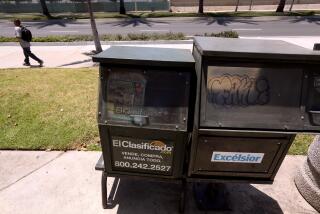Competition for Night Stories : Free-Lance Video Units Race Each Other for News
It’s past midnight and free-lance news cameraman Chris Doyle is speeding along Los Angeles’ Harbor Freeway, breaking the law to beat his competition to the scene of a murder.
Doyle, a 23-year-old journalism school graduate, works for Los Angeles News Service (LANS), which sells video films of fires, traffic accidents and murders to local television stations whose camera crews sleep at night.
His competitors are two other late-night, free-lance news crews who battle for action shots.
Both of those--Southern California News Service and Newsreel Video Service--are owned by former employees of Los Angeles News Service.
Need High Volume
“On the whole,” Doyle says, “we beat them 80% of the time. But they survive because they’re much smaller and can make it on one sale a day. We need to sell at least five, six stories.”
Recently, the competition was so fierce that another LANS cameraman, Chris Torgerson, got into a shoving match with Newsreel Video Service operator Gary Arnote, who had filmed exclusive footage of firefighters freeing rock musician Little Richard from his car, which had crashed into a light pole in West Hollywood in October.
LANS is owned by Bob Tur, a 25-year-old entrepreneur who bought his first video camera in 1979 with $50,000 he had earned as a private detective.
“My wife and I were eating pizza at that time,” Tur said. “We saved everything we had and bought the equipment. That left us pretty much broke.”
Equipment Helped
With state-of-art video cameras, Tur and his brother, Steve, soon forced other free-lancers “out of business.”
Today, LANS is affiliated with Independent News Network, a national television news organization that sells its broadcasts to smaller stations. Tur claims that 26 clients “use us every day.”
LANS, staffed by 22 full- and part-time employees, including three members of the Tur family, made about 3,500 sales in 1985, raking in $1.6 million, Tur said. But he said his company also spent that much to stay competitive.
“We’ve had a cash flow problem since we started. But we’re trying to make a news presence--to be the wire service of video.”
The other two video services are not nearly as large as LANS, but their owners hope to expand and get clients who presently are using LANS video.
Tried to Go Solo
Mark Curtis, who was Tur’s partner when LANS first started, kicked off his own video news service, Southern California News Service, only months after LANS was formed.
Until recently, Curtis’ crews worked through the night, but a “slim profit margin” forced them to stop.
Southern California News Service, does, however, continue to operate during the day, Curtis said, and makes sales to the stations because “they’re covering news conferences and we’re covering things that are breaking.”
“The stations split the sales between the three of us because they need us all to stay afloat. They’d love to have everybody in town with a camera.”
Arnote’s Newsreel Video Service is the smallest of the three, but he frequently beats the competition to the scene because of his familiarity with police and fire officials.
Mostly Works Alone
Arnote, whose parents mortgaged their home so he could buy a $14,000 video camera, works alone and occasionally hires free-lancers to cover him during his time off.
He says he has an edge over the other crews because of his years of experience, especially as a still photographer who often sold pictures of fires to arson investigators.
In the middle of the night, when things are slow, Arnote and Doyle and other independent video operators often go to police headquarters downtown, where they can listen to police scanners and jump to work if a fire breaks out or someone is shot to death or killed in an accident.
“Then everyone pushes and stomps to get out to the scene first,” Doyle said. “We drive like maniacs.”
More to Read
The biggest entertainment stories
Get our big stories about Hollywood, film, television, music, arts, culture and more right in your inbox as soon as they publish.
You may occasionally receive promotional content from the Los Angeles Times.










